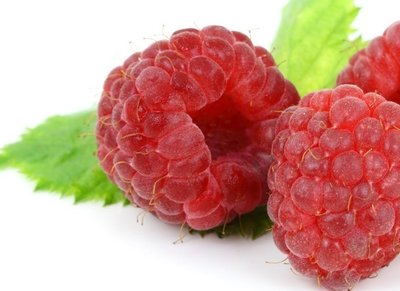Growing Raspberries
Organically for Raspberry Jam, Wine, Jelly, Tart ...
If you have ever tasted
the flaccid,
tasteless
raspberries you get in the supermarkets, and eating raspberries freshly
picked
from your gardens and homesteads, there is a very big difference! This
is because raspberries
lose their
taste, color and texture hours after
being picked.
Raspberries need far more packaging
than usual because they
don’t travel well, and are really not suited for supermarket sales.
Raspberry plants are hardy, easy to grow, quick to produce a harvest
and grow well with little care and fuss.
Therefore well worth the
effort of the initial set up of stakes and trellis wire when growing
raspberries organically on your farms, homesteads and backyards.
In this growing guide we will show you how to grow raspberries
successfully no matter where you live. In fact, raspberries can be grown
anywhere, from the Arctic to the equator! With over 200
different types of raspberries you are spoiled for choice.
Growing Raspberries Successfully

Freshly picked organic raspberries
To increase the acidity in the soil
make sure
that well-rotted compost
has been planted before starting. Raspberries
also do not like lime, so do not add this to your compost
or use
mushroom compost.
By planting the canes in late fall,
early winter
and by planting early, mid and late season cropping cultivars you can
have raspberries throughout the summer and fall months. If you look
after your plants they can carry on producing until they are about many
years old.
There are both yellow and red varieties, but the yellow fruit is milder in taste, and I have to say that I prefer the red raspberries. There are also orange, black and purple varieties.
Yields of Raspberries per Acre
When looking at yields per acre you can expect 4000 pounds per acre of red raspberries as opposed to 2000 pounds per acre of the black varieties. On average you can expect 60 - 70 pints of fruit per 100 foot row.Growing Raspberries: How many Raspberry Plants should you Plant?
Do not plant your raspberry plants in an area where either raspberries or strawberries have been planted before, for at least 6 years. This is to prevent picking up soil-borne diseases.If you want to make jams and jellies,
and pies with
the excess fruit, then you
should
plant between 15-20 plants per person
in your family.
Growing Raspberries: How to Plant and Care for your Raspberry Plants?
If you are planting bare-rooted stock
you will need
to pre-soak
these in water
that as some seaweed
fertilizer added to the
water. Soak for 30 minutes before planting out. The seaweed acts as a
tonic and will give your canes a good boost. When you plant them make
sure that you plant them at the same height as they had been planted
before, by using the soil line as a guide.
If you buy canes that are in bags of
soil from
your local garden shop or supplier, make
sure that these are not in
leaf already. Buying them when they are already in leaf
will
result in
damaging your plants as you try to separate them at planting.
Dig a trench and fill with well-rotted farmyard
manure
and compost. I also add a handful of blood and bone at
intervals
down the trench and sprinkle it on the soil and dig in well.
Plant
the
canes in rows from north
to
south so that they can get enough sunlight
2 meters apart. When planting the raspberry canes in the rows
themselves space them at 40-45 cm apart. The plants themselves should
not have their roots more than 5 cm below the soil line.
The
raspberry canes
will need support. The best way of
supporting them is by placing supporting posts 2-3 meters apart use
stranded wire either in 2 or 3 strands for the canes to grow up
against. The strands can be spaced at 1m, 1.5m and 2m for support. You
really don’t want them to get beyond 2 meters, so once they get to this
height, cut the tops of to contain them at this height.
Once planted, mulch
the new plants to keep the
roots cool, but not up against the canes themselves as this will cause
disease. Raspberries enjoy a protected site that will receive afternoon
shade.
When the flowers appear in the spring
take 4.5L
of water and add 2
teaspoons of Epsom
salts and 2 teaspoons Sulfate of
Potash. This will give a boost to the plants by supplying
magnesium and
potassium. Magnesium is
important
for producing energy, and potassium
is important for protecting the plants against disease,
and to
improve
the flavor of the berries.
As the canes grow, support with string,
plastic
training clips or even
jiffy ties work just as well.
Growing Raspberries: Pruning Raspberry Plants
Leave the canes of summer-fruiting
raspberries
unpruned in their first
year;
they will bear next season’s crop. In
the
second year and following years, once all the fruit has
been
picked, cut all
the fruited canes only down to ground level.
Raspberries
produce
fruit on canes from the
previous year. Once they have borne their fruit, the canes
will
look a
little worse for wear, and well-spent. These need to be pruned at
ground level, and the green canes need to be tied onto the stakes to
ensure good growth.
Ensure that all canes are tied into the
wire or
posts so that there are none on the ground. Any dead canes should be
pruned at ground level as well as any shoots that are weak. You want to
leave about 10-12 strong
canes per
meter, and remove any canes that are
growing far away from the parent plant.
Mulch the plants with well-rotted compost every fall and with cut
Lucerne in the spring. Water the plants well, particularly when the
weather is hot and dry and the fruit are forming. Once the fruit
appears, feed with a
seaweed
fertilizer to give your plants a tonic.
Autumn-fruiting
raspberries are simpler to
prune: every year, including the first year, cut all the canes to the
ground once fruiting is over. After pruning remove any old mulch.
Growing Raspberries is for the Birds!
Growing raspberries for your family is
one thing,
but growing raspberries for the local bird population is another. In
order to protect your crop from marauding birds you will need to drape
netting over the bushes. This needn’t be expensive. One
can use
cheap
net curtaining but make sure that what you have chosen will still allow
enough light into your raspberry plants.
Growing Raspberries - Fungus Attacks, Beetles and Viruses
 Raspberry Beetle (seen left).
For some, birds are not the
only problem. Raspberries can be attacked by the raspberry beetle, also
called the raspberry
fruit worm,
which lays eggs which then later turn
into small worms, or maggots which burrow into the fruit and eat the
berries.
Raspberry Beetle (seen left).
For some, birds are not the
only problem. Raspberries can be attacked by the raspberry beetle, also
called the raspberry
fruit worm,
which lays eggs which then later turn
into small worms, or maggots which burrow into the fruit and eat the
berries.
The raspberry
beetle
isn’t very big, but you will notice it
immediately when you see it. It is reddish-brown in color and has short
hairs covering its body.
By looking at the leaves at mid-spring it will be obvious
that the beetle is present as the
leaves will be eaten away
in multiple strips inside the leaf boundary. The amount of damage to
the leaves will indicate to you how bad the infestation is. Once your
berries are infested those that have brown-grey patches at the top
edges are the ones that have been affected.
The worst of it is that after the worms
pupate
they fall to the soil and remain there until the following spring. For
those of you are not too fussed by the worms, you can soak the berries
in some salty water for about 5 - 10 minutes. This flushes the worms
out and the berries can then be used. For those of you who don’t like
the idea, and I am one of them, I have to confess, then you will need
to apply a natural insecticide like
Neem
to your raspberry plants to
prevent damage by this beetle.
You can also use pheromone
traps to allure
the beetles. These can be placed at regular intervals along the rows
and emptied periodically.
Growing Raspberries and Fungal Attack
Another problem with growing
raspberries is a fungal
attack that grows on the canes in patches. You can see
patches
around
the buds that start off as purple and then later turn silver and
finally spreading so that the upper canes die of. This is a problem
that develops during a particularly wet summer. The only option is to
cut out the affected areas and to burn the cuttings.
Growing Raspberries and Grey Mold
Grey mold can also affect raspberries
when the
weather is wet. It starts off as a grey
fuzz that appears on the fruit
and spreads where fruit is clustered close together. The best way to
deal with this is to remove the bunches of fruit, and open up the rest
of the fruiting areas by removing a large number of the leaves that are
forming canopies that cause conditions that are too humid for the
plants’ success. By removing the leaves, you allow more air to
circulate and you allow more sun to get to the fruit.
Growing Raspberries and Mosaic Virus
Finally, watch out of plants that appear to be struggling to grow, are not producing as many berries as they should and which has tell-tale irregular yellow patches on the leaves. If you are not sure what it is, and you think that it is a mineral deficiency give them a good dowsing of the Epsom salts tonic mentioned below.
However, watch closely, and if your plants do not improve after this
application then it is almost certain that you your raspberry plants
have the Mosaic virus. There is no alternative, once this has been
established, then to remove the plants completely by digging them out
and burning them.
Growing Raspberries: Harvesting your Raspberry Crop
You will not get your berries all in
one go, they
will ripen over many weeks and therefore you will need to visit your
plants often to check when they need to be harvested.
If you have
planted the summer
variety,
rather than the fall variety you will be
harvesting your berries in July and August, if you live in the northern
hemisphere. Make sure that your hands are well protected from the
thorns as picking the berries can be a painful experience if you are
careless. Take the fruit and gently squeeze it, without damaging the
structure of the berry, and pull.
Growing Raspberries and How to Store Them
Raspberries are very fragile and don’t keep very well. Therefore, it is better to eat the fruit within 2 days after it has been picked and refrigerated straight away. Pick, rinse gently and pat dry. Place on a paper towel-lined container with more paper toweling on the top to absorb any moisture. Eat as soon as possible. Raspberries can be frozen. Make your jams, jellies, smoothies, shakes, tarts etc. as soon as you can after picking your berries to maintain the flavor.See more information on preserving
food and your raspberries.
Growing Raspberries for Health Benefits
This fruit is rich in Vitamin C, A, B1, B2, B6, C, E and K, manganese, fiber and high in antioxidants. They are also rich in folic and nicotinic acid and omega-3. Raspberries are considered on of the top superfoods due to their high levels of antioxidants.
Growing Raspberries and Using your Excess Raspberries
Use in pies, jam recipes, jelly recipes, shakes, vinegars, wines, canning recipes, ice cream recipes, baking and sauces. Also use them in making yogurt.
Of course you can also find wild raspberries as edible wild plants!
Add
your Own
Comments on Growing Raspberries Organically.
Leave a Comment
Do you have anything that you would like to add after reading this page? We would love to hear your thoughts. If you can add additional information to what has been written here you will be adding value to the website! No need to have any special skills - just type and submit. We will do the rest!












New! Comments
Do you have something of value to add? Leave me a comment in the box below.